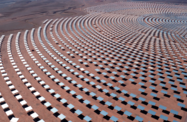Morocco: Renewable energy drive gains pace
 En Français
En Français
Ambitious plans to increase renewables in Morocco’s energy mix have taken another step closer to completion, following the announcement that Africa’s second-largest wind farm is to be built in the south of the country. Morocco is looking to attract up to €2.8bn in investment under a strategy that is part of the National Renewable Energy and Efficiency Plan, launched in 2008. The programme aims to improve grid efficiency and generate 42% of domestic needs from renewable energy by 2020. The strategy is part of a broader attempt not only to improve environmental sustainability but also to meet rising consumption levels – which jump by an average of 6% year-on-year – and reduce a heavy dependency on fossil fuel imports.
The wind farm, which will be built in the southern town of Tarfaya, will add 300MW to the national grid once fully operational and will provide 40% of Morocco’s wind-generated electricity, according to France’s GDF Suez. The French utility will be rolling out the wind farm project in partnership with local energy company Nareva Holding. Earmarked to be up and running by 2014, the project will be instrumental in helping Morocco reach its target of generating 1000MW of wind energy by 2015, rising to 2000MW by 2020, a goal laid out in the Wind Energy Programme. A total of 131, 80-metre-long turbines, each with a capacity of 2.3 MW, will power the new farm, which when completed will be the second-largest capacity project in Africa, behind a 310MW farm currently being built in Kenya.
Tarfaya’s favourable weather conditions should allow the farm to generate wind energy around 45% of the time compared to other facilities, which manage levels estimated between 20% and 40%.
The project will be constructed at an estimated cost of €450m as a build-own-operate-transfer contract. Morocco’s financial institutions are expected to lend 80% of the funds needed to bankroll the project, with the remaining 20% financed in equal share by GDF Suez and Nareva Holding. The national electricity and water provider, Office National de l’Electricité et l’Eau Potable (ONEE), has signed a 20-year agreement to purchase electricity produced by the farm. Morocco is far from the only North African country looking to increase renewable production in its electricity sector – with Algeria, Tunisia and Egypt all having licensed pilot projects for both wind and solar in recent years – but the Moroccan wind farm is the latest in a line of renewable energy projects inaugurated in recent years.
The Ouarzazate facility, for example, is the first contract under Morocco’s €6.62bn Solar Power Plan to build five solar plants nationwide between 2015 and 2019. The €736m contract for phase one of the Ouarzazate plant was awarded to a Saudi-Spanish consortium in late 2012 and is expected to be complete by 2014. The second phase of the project should see capacity expanded from 160MW to 500MW. The plant is expected to reduce the country’s carbon emissions by 3.7m tonnes per year.
The first wind farm, which is being developed near the town of Taza in the north, should be completed by 2014. The 150MW project forms part of the first phase of the Wind Energy Programme and marks a joint venture between ONEE, French EDF Energie Nouvelles (EDF EN) and Japan’s Mitsui.
A number of projects are set to follow, including the construction of five additional winds farms. The ventures, which form part of the second phase of the Wind Energy Programme, should add 850MW to output.
A total of 16 companies, including the German firm Siemens, Enel Green Power in Italy, the Denmark-based Vestas and Spain’s Acciona Wind Power, submitted bids in 2012 to participate in the construction of the new wind energy projects. A tender was also launched to repower the Koudia El Baida wind farm to supply the technical equipment and assistance needed to enhance capacity by 100MW. A second phase will focus on extending the farm and installing new turbines to add 200MW.
The sites for the new wind farms extend to both the north and south of the country, including Tangiers II, Boujdour, Tiskrad in Laayoune, Midelt, and Jbel Hdid in Essaouira. The projects will take the form of public-private partnerships (PPPs), with institutions such as ONEE, the Energy Investment Company (Société d’Investissements Energétiques), and the Hassan II Fund for Social and Economic Development (Fonds Hassan II pour le Developpement Economique et Social) earmarked for key roles in developing the farms.
Morocco looks to be heading in the right direction to meet its 2020 target. ONEE has been allocated Dh12bn (€1.08bn) to improve and extend the distribution network, which should produce results by 2016. With more projects due to be rolled out, the country should edge closer to achieving its long-term objectives of reducing a reliance on energy imports, currently standing at 90%, and meeting rising demand for electricity.



